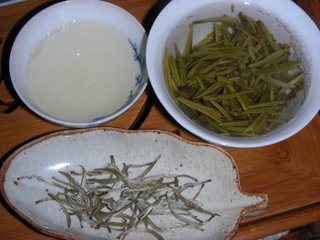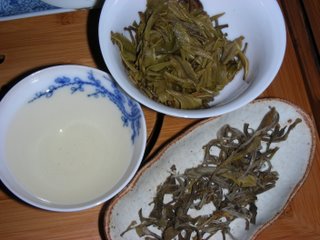
Sun Dried Bai Mu Dan
This is my favorite out of the 4 greens. Although I am not a big fan of green, this Bai Mu Dan has the floral aroma of a dan cong, sweetness of a pu-erh and the lightness of a green without the bitterness and grassiness.
4g, gaiwan, crab eye water, bottom throw
It started with a strong sweet floral aroma, liquid is clear yellow, sweet, a lot of flavor for a green. Being sun dried, it should be categorized as white instead of green?! Well, it has all the characteristics of white, no much of green at all. It can take long steeping and hot or warm water, taste great hot or warm. The flavor does not turn bland in anyway. It's a great tea for beginners and every day office drink. You can't make a bad cuppa with this tea no matter what tool you use. Well with the exception of bad tap water maybe. Love it! A good skilless tea.

Silver needles
Attractive looking leaves, young and hairy, though not as hairy as some others I have seen. It's also on the thin side.
4g, gaiwan, crab eye, bottom throw
It was nutty and grassy, astringent, very light yellowish color, sweet after taste, dry mouth feel afterwards, can't take long infusions. It's decent, but nothing to brag about.

Jade pole
interesting looking tea, my first perception was these might be some old leaves. Turns out they are very young and tender, long thin leaves picked right after spring rain.
4 poles (4g), gaiwan, crab eye, bottom throw
Sweet and nutty, a bit astringent, slight sweetness, last 3 brews, faded quickly after the second. Its flavor is better than the silver needles.
I had 3 out of 4 greens so far for the day, and already drunk. But, I am going to hit one more - traditional bai mu dan.

Traditional bai mu dan
This is a true green version, steamed then dried.
4g, gaiwan, crab eye, bottom throw
Light floral, grassy, hint of nutty and astringency, sweet and nutty after taste, last 3 brews, mild in every way as a typical green. Bitter and astringent when steeped for long.

Difference of the 2 bai mu dan
Left: traditional (steamed green); right: sun dried (fermented during drying). Sun dried version is very flavorful compared to the steamed version. The fermentation allowed the break down of the sugar, gave it a honey like sweetness brew after brew. This is my re-orderable item.

7 comments:
Well... i've got few thoughts on difference btw 2 BMD.
I think, that sundried is a real one and so called traditional is not BMD but Liu Mu Dan or 'Green Peony'. And this is really green tea. It looks similar to what I've tasted. But if it was steamed, it could be yellow variation of BMD, cause steaming is applied in case of Czun Shan Ying Zheng mainly. And this is top yellow.
Also, in the case of Silver Needles or Bai Hao Ying Zheng I'd recommend using middle throw, bigger amount of tea and water of approx. 70 degrees per Celsium.
It works well.:-) Thanks for sharing this experience!
Innerspace:
Thanks for sharing! I need to find out more about yellow.
From what I understand, greens are mostly steamed right after harvesting to "kill green" or sa ching, then dried either by air or fried in case of Lung Jing. Whites skip the steaming then dried by artificial created warm air flow, the quick drying process prevents fermentation, unlike sundrying that's slow and the leaves ferment quite a bit before completely dried.
I'll try different throws as you suggested. :)
As I know there are many variations in producing green tea, but the most common stages are:
1) a little sun drying
2)twisting the leaf
3) 'killing green' - panfrying for a limited time
4) leaving to rest for some time (fermentation takes place here)
5) another frying but usually in a special oven where very hot air is applied to tea to stop fermentation.
And yellow tea is produced similar to white tea, but it's warmed up over the fire or steamed, then immediately put into the thin paper coating where it's fermented up to 10 percents and then it's sundryed or process n 5) is applied.
Sorry for my english - it's not my native language so I could've made some mistakes.
;-)
I've got a small addition.
Very often panfrying is done in a bamboo baskets and the fire is not direct though.
And the special oven in the last frying(baking suits more here I guess) process is simply bamboo basket placed over characoal:-)
It could be seen at Stephans blog(teamasters)
Thanks for sharing! :)q
Beautiful blog, congrats and thanks.
I apologize for my ignorance, but what does "bottom throw" and other "throws" mean?
Thanks for going through all 4 teas at once, even if it made you a little tea drunk!
Salsero,
Thank you!
Here is an article about "throws". Hope it helps. :)
http://tea-obsession.blogspot.com/2006/10/how-and-when-to-put-green-tea-leaves.html
Post a Comment